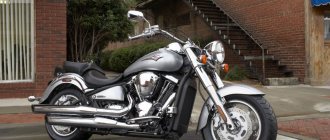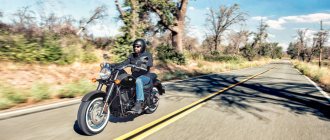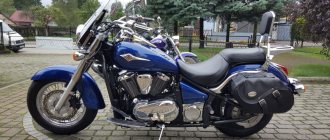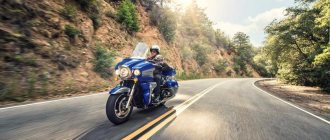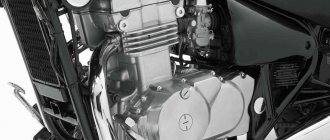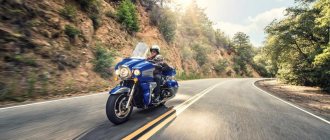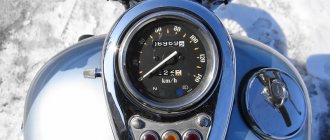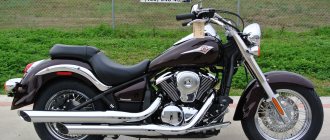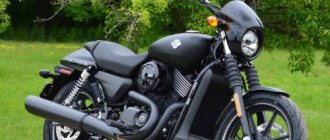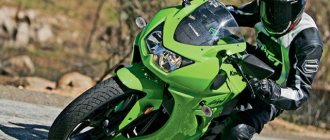Review of the Kawasaki Vulcan S (EN650S) motorcycle
It turns out that none of my non-motorcyclist friends knows what a cruiser is)) Chopper is immediately clear to everyone. Removing and installing the seat is a pain. I got used to the classics - I opened the lock with the key and that’s it. Immediately: remove the side trim, take out the key under it, use it to unscrew the screw, remove the seat. Install it in the reverse order, and by touch, install the side trim at the same time: with the pin in the hole, two guides in the slide and the lock tongue in the recess. Now I understand why cruisers don't take advantage of the space under the seat. You go over all road bumps more slowly. You can contrive and stand up on the footrests, but this will only make it worse - you will get a significant kick in the ass with the seat. This was expected and did not come as a surprise. The reverse side of the previous point is an insane thrill for the knees in the long run. If you want, straighten one leg and put it on the footrest, or if you want, both. I screwed the rings on the Ring Road for break-in - 500 km at a time is not a problem. If it weren’t for being chilled to the bone at t +7 (data from the info board above the Ring Road), I would have driven it in a day. Sixth gear is very good. 4000 on the tachometer and the speed is about 100 km/h, 6000 - 130 and the engine does not strain. 130 km/h is not a comfortable speed due to air pressure. I don’t know what makes such a difference in aerodynamics compared to the classics, but on the latter I bent over the steering wheel and everything was ok. No matter how you bend over on the neo-chopper, the helmet tries to press your nose and chin into the depths of your skull)). Do not offer wind deflectors! Only hardcore! Hardly driveable only! ))) The engine gives excellent dynamics. The long wheelbase doesn’t even hint at the front wheel coming off, but just a little bit – the rear wheel washes. The box clicks easily and naturally. The first with a slight knock and a slightly noticeable jerk. Working zone from 4000 to 9000 rpm. If you were a little lazy and didn’t put in a lower gear when accelerating/overtaking, you end up with clanging valves and shaking mirrors. Chu! I pressed the clutch, it went away, but the dynamics are not the same, it’s still better to switch to a lower gear. If you don’t forget about this, everything is great. I learned what easy handling is. I don’t understand why the W650 was so hard to corner, maybe because of the old school Firestone Deluxe tires. The Vulcan S makes it easy and effortless. At some point it starts to seem like enough is enough, this is not a sportbike. In addition to the type of tire, the size of the front disc apparently also affects it: 19 versus 18. Direct detour around the potholes is so easy that, having become impudent, I started doing it with one hand, I need to stop. )) Now I understand why all the testers praise the handling of the Vulcan S so much. The data reflecting the estimated distance to the reserve in the tank shows almost instantaneous fuel consumption. This is convenient for long-distance travel and very confusing in the city. When driving from traffic light to traffic light, it is better not to look at these numbers at all; a long scale of divisions of the fuel level in the tank is quite sufficient. For example, with constant movement, 100-110 km/h shows 350-400 km to the reserve, but if you turn it up - 150-180 km to the reserve. The sound of the standard exhaust in place and in traffic jams is absolutely nothing, there is simply no sound. It doesn't exist at speed either. But wow, how I like to suddenly add gas in 5th or 6th gear. From 4000 rpm, a rich, bass rumble bursts out of the exhaust system up to 8000, then it fades away. If I play something like Two Brothers or Arrow, it will definitely only be with a DB killer. For long-distance direct flows, my firm answer is NO! You have to get out of the habit of moving your feet in traffic jams at near-zero speed. From the classic height it is very comfortable (to move your feet), but the chopper low seating position turns you into a praying mantis))) When braking, the body weight is not all on the knees squeezing the tank, but is also distributed over the feet resting on the footpegs.
Bottom line: here I can only thank Kawasaki for a bold attempt to combine the incompatible and cram in the inconvenient, I got everything that I was missing on the W650: Ruff dynamics + comfortable, relaxed Vulcan seating = my knees no longer go numb, and even during acceleration At 650cc, sometimes you have to grab the steering wheel tighter. I am delighted!
Go to Kawasaki Vulcan S (EN650S)
Check out the test drives:
- Kawasaki Vulcan S: Comparison test with Honda CTX700
Kawasaki VN1500 Vulcan: Test drive from Motorreview
What does the president of the Moscow Vulcan Club drive? Weird question. Of course, on a Kawasaki Vulcan, and not just any ordinary one, but the largest and most luxurious one - Kawasaki VN1500 Classic Tourer . However, Ilya chose this car not only based on external appearance. According to what? Details in the owner's material.
, I had a smaller “Vulcan” - Kawasaki VN800 Classic A. I liked everything about it (I drove almost 30,000 km), with the exception, perhaps, of one thing - it’s not very comfortable to travel long distances. After “hundreds” the engine is rather weak, and its modest weight does not allow you to feel confident on open highways. After returning from a trip to Europe again, I decided to find a replacement for him. I admit, parting with the “eight hundredth” was very difficult.
Oh, how many kilometers we have lived together, how much tuning and useful improvements have been made! Became a relative, a member of the family! Therefore, I decided for myself - if I’m going to give it away, then it should be in good hands. For example, to a friend. And so it happened.
Why Kawasaki VN1500 Classic Tourer ? It's just hi-end in the Vulcan family. Not only is this a customized “tourist”, but it also comes with a full set of factory tuning. There is no need to invent anything or look for anything in catalogues—everything is included from the very beginning. And the fuel-injected engine, alloy wheels, windshield, plastic lockable cases and reinforced brakes are very useful.
In general, when I first saw this abundance on one motorcycle, I immediately understood - I just want it! This would take you to the end of the world. Apparently this is fate. Because I sold my “old” one and bought a new Vulcan almost on the same day. Then the enthusiastic jitters from the new purchase ended, and surprises began. The first day I just spat! Lord, what have I done! I sold the good girl, and in return I got a hulking hulk!
The grinding has begun. We got used to each other, changed ourselves, got used to it. Gradually, along with negative qualities, I began to notice clearly positive ones. What I didn’t like, I tried to improve. The first thing I did was change the steering columns. Your humble servant does not boast a gigantic height, so I had to lower the steering wheel slightly - the 4-inch struts are slightly bent towards the pilot. It immediately became easier to steer, especially at low speeds when turning. The second replacement is related to glass. Although the main “burdock” has five adjustment positions, it is clearly not intended for short drivers. After 120 km/h, a turbulent flow arose right in the area of the helmet - my head began to shake so that “Mom, don’t worry.” The problem was solved by enlarging the lower glass deflectors.
The more I drove it, the more I fell in love. I already liked everything: the huge mass (the wind is on our side!), the huge silhouette (the cars scatter in a scattering manner), the inertia (as if giving the pilot time to think about the maneuver), and, of course, the spaciousness. Not only is it easy to load with everything you need for a trip, but two people can easily travel on it. Of course, it loses in dynamics, but on the track you feel more confident. It “stands” on the trajectory like a glove, rides as if on rails. The chassis turned out to be very rigid. The device feels very comfortable even at high speed. If on the “eight hundred” my wife and I accelerated to 190 km/h and froze in horror, then on the “tourer” even 180 km/h - the flight was normal.
But let's get back to the main thing. The real revelation for me was the Tourer's low-speed handling. The weight distribution of the car is simply excellent; when you are moving in a traffic jam, you can even freeze in place for a few seconds and continue on your way again, putting it in turns like a tumbler. True, we must not forget about uniform loading of the cases. Their mass affects handling. By the way, about trunks. We still have to come up with something better! Firstly, they are locked, secondly, they do not get wet and, finally, allow you to place everything you need there, for example, musical equipment. Which is exactly what I did.
I would also like to note the ergonomics. The pilot behind the wheel (already modified for himself) is very comfortable. The wide platforms for the feet, the gear shift lever with two paws, and the thick steering wheel handles are very comfortable. Vibrations are kept to a minimum. Only on the steering wheel at a certain speed (110-120 km/h) there are “spikes”. There are other fly in the ointment. The “tidy” on the gas tank as standard is practically unreadable during the day, and at night it generates a whole range of multi-colored lights on the inside of the windshield.
The solution to this problem is simple: you need to install a visor on the outer part of the speedometer dial. By the way, if you are going to ride the Kawasaki VN1500 Classic Tourer with an integral helmet, then in order to see the readings on the instrument panel, you will have to lower your head down. Otherwise, the “jaw” interferes with visibility. Another nuance with mirrors. No, they have good visibility and have no blind spots, but they are very difficult to set up.
To set the required angle, you first need to remove the rubber seal around the perimeter, then the mirror, and fasten the bolts inside the housing. With one of these settings, I cracked the left mirror. I would also like to note that the position of the passenger footrests is not entirely correct. They are designed so that the second number is as comfortable as possible. But the driver pays for this comfort. When starting off, or in maneuvers when you move your feet, the boot can get into the gap between the platforms and get stuck there. It's an unpleasant feeling, I admit.
I would also advise you to park this Kawasaki VN1500 Classic Tourer only with the rear wheel facing the curb. There was a case where, with my own efforts, I was unable to reverse this 350-kilogram colossus up an easy hill from the parking lot. These attempts looked very comical.
The chassis, as I already said, is rigid and durable. And a lot of credit for this goes to the pendants. The front fork perfectly “swallows” the imperfections of the track and does not suffer at all from the “dive effect” that is so typical of large cruisers. The rear shock absorbers are the height of perfection. They can be adjusted right on the road to suit any type of road surface and any vehicle load. After all, the shock absorbers are adjustable for spring preload and inflation fittings up to 2 atm. air.
Now about tuning. Although I consoled myself with the thought that there was nothing to bring to mind here, but... I started with the trunks. You throw your leg over the motorcycle when you get off or on, and you scratch the plastic. To prevent this, I installed chrome grilles on top. This time. Two - arches for the cases, so as not to scratch when tilting or falling. Then the same chrome “kenguryatniki” on the front and rear fenders. Cute!
Now it's time for the seat - a lower Mustang with a backrest. But, I admit, there was a mistake (it’s inconvenient to drive such a colossus, especially with a wide steering wheel from somewhere below, and in a brace), and then I returned everything back. I installed “music”, all sorts of overlays, things, visors. But even with the realization that the Kawasaki VN1500 Classic Tourer was becoming more and more elegant with every detail, I tried to dose out the infusions. Stretched out the pleasure. The main thing in our business is the process... Probably the most useful of the improvements was the third top removable case (what you need for traveling) with a trunk, the installation of reinforced hoses and a reinforced clutch. Although now working with the left lever in traffic jams has become somewhat more tiring.
Three seasons behind us, and some conclusions have already formed in my head. What should you buy first? 90-degree adapter for wheel inflation. The fact is that the valves are located very inconveniently. At the front, access is limited by wide brake discs, and at the rear there are mufflers, arches and panniers. The second feature is that the motorcycle is very difficult to repair. To get to any detail, you need to scatter half the device. As mechanics say about the Kawasaki VN1500 Classic Tourer , it’s a cool motorcycle, but there are so many of them! However, it is unlikely that users of such a model will do anything themselves. It is also worth paying attention to the following feature.
The exhaust pipes here are not chrome-plated, but covered with chrome plates. The latter are attached using clamps. So, don’t be surprised if, once you remove this piece of hardware, you won’t be able to put it back - the clamps are practically disposable. However, you can treat them by bending back the dented area with the notch. It is very difficult to maintain the front “telescope”. To simply change the oil, you need to remove the feathers and drain the liquid through the top. And to do this, you need to dismantle a whole bunch of everything. It's strange why there are no drain fittings at the bottom, like on the Honda? What else? The Kawasaki VN1500 Classic Tourer is sensitive to tire wear. As soon as the tire becomes a little bald, the vehicle begins to turn its rear wheel and wobble at high speed. And finally, the last thing is low ground clearance. Most motorcycle curbs are insurmountable.
Now about the advantages. The neck of the tank is conveniently made - you can refuel without straining until it is full at the cut-off point. By the way, with its considerable weight and engine capacity, the cruiser “eats” very modestly - 5-7 liters per “hundred”. It was nice to find self-canceling turn signals. Not every “Japanese” flaunts this option. The glove compartment for tools is very rationally designed. It is noteworthy that despite the above-mentioned difficulty in repair and maintenance, the model is extremely convenient.
The spark plugs are unscrewed “one-two-three”, the air filter is even faster, the oil filter is located at the bottom in a recess, which eliminates accidental damage. The on-board system tests numerous system sensors each time and signals failures if something happens. And the injector itself is a simpler thing than the same carburetor. Here, if something is clogged, it is immediately clear what exactly it is. True, clogged injectors are a common occurrence on our gasoline. Typically, the spark plugs fail within 2000-3000 km.
Do you think that thin side arches are just decoration? You are wrong! They not only give the appearance a special charm, but protect the bodies (motorcycle and pilot) from sliding on the asphalt. I really didn’t think that a collision with a dog could result in such a minimum of destruction - I just chipped off a couple of millimeters of metal on the arches. The device simply lay down on them and in this position plowed several meters of the road surface. The driver escaped with a slight fright. Even the panniers were not scratched!
So this “volcano” gave me only positive impressions. On the track he is the leader.
Go to the Kawasaki VN 1500 Vulcan
- Read review of Kawasaki VN 1500 Vulcan
Check out the test drives:
- Yamaha XV1600A: Comparative test drive with Kawasaki VN1500 Vulcan Drifter
Who is this bike for?
Among the advantages of this bike:
- powerful engine for its time and class;
- spectacular design, not inferior to the best classics;
- reliability.
The motorcycle has a long and glorious history. The model began production in 1985, when Kawasaki was not yet famous for its beautiful classic cruisers. Then the bike created a real sensation with its appearance and serious contents. He represented great competition for his American classmates.
Dimensions and weight
This motorcycle is medium in size. It reaches 2295 millimeters in length. The saddle height is 735 millimeters, while the overall height is 1225 millimeters. The wheelbase reaches 1580 millimeters. The width of the motorcycle is 850 millimeters.
The curb weight of the bike is 236 kilograms, which is not much, considering that we are talking about a classic. A cruiser simply cannot be too light, it goes against its concept. With its weight and tank capacity of 13.5 liters, the motorcycle can travel on average 400 kilometers without refueling, because the average fuel consumption per 100 kilometers is 4.8 liters.
Kawasaki VZ750 Twin is the name for the Japanese market. In fact, this cruiser is one of the founding veterans of the famous Kawasaki Vulcan chopper line, and it received the name VZ750 for sale in the Japanese domestic market. Produced since 1984, this motorcycle was Kawasaki's first foray into the cruiser segment. And this experience turned out to be successful - despite its advanced age, many VZ750s are still riding on the roads.
At the time when this motorcycle was developed, they did not particularly care about the environment, and the engines were not “choked”, so the 750 cc liquid-cooled V-twin produces as much as 66 horsepower - noticeably more than, for example,
the Kawasaki VN 900 Vulcan . True, the cardan takes away some of the power. Yes, yes, this is the only Kawasaki cruiser of this size equipped with a cardan - usually the company installed a chain or belt, as, for example, on the Kawasaki EN 500 . The gearbox is a classic, five steps. By the way, it is equipped with an interesting “trick” - you can only plug in first gear or neutral on the spot. The remaining gears on the Kawasaki VZ750 can only be engaged while moving. Owners note that this greatly simplifies the search for neutral. However, the gearbox on this motorcycle works very well even without this - clearly and without “false” gears.
Externally, the VZ750 is built according to the canons of the American school of motorcycle building - an archaic cruiser, created for imposing movement on highways. True, despite the fact that this motorcycle was not at the forefront of technical progress even during the years of its release, it is still good. Dynamic and quite light (dry weight - about 225 kg, comparable to the Yamaha Virago in its 1100 cc version), the Kawasaki VZ750 also handles very well - this is due to the small fork angle, not too wide rear roller and low center of gravity. .
The suspension, of course, is extremely simple - it is, after all, a cruiser, and moreover, developed more than thirty years ago. You can’t expect sharp control from it, nor a high level of comfort - it just is there, and nothing more. However, the Kawasaki VZ750 suspensions are quite good for gripping on the highway, but on a rough road, all the bumps will be carefully transferred by the shock absorbers to the rider’s fifth point. However, the rear suspension is adjustable over a fairly wide range, which improves the impression of the VZ750's driving characteristics.
The brakes are an ancient system, and, perhaps, they were not good enough thirty years ago. There is a drum on the rear wheel, which is of little use, and on the front wheel of the Kawasaki VZ750, the designers installed two 226 mm brake discs and single-piston calipers - also not a fountain, let's face it. Upgrading the VZ750's braking system is highly advisable if you plan to ride this motorcycle.
The gas tank capacity is thirteen and a half liters - not so much. However, taking into account the average consumption at 110 km/h of approximately 5 liters per hundred, the Kawasaki VZ750 is capable of covering more than two hundred kilometers without refueling. Not the most impressive parameter, of course, but not the saddest either. But it is comfortable to sit on the motorcycle, and for owners of almost any height - all controls are well located, and the ground clearance also allows you not to be afraid of the frame getting caught on some speed bump.
Even for its time, the Kawasaki VZ750 was not the most modern motorcycle, and these days this road veteran even more looks like a ghost from the past. But the huge margin of safety built into this motorcycle makes the VZ750 a very interesting and practical model.
Similar articles:
- Kawasaki VN 750 review
- Kawasaki VN 900 Vulcan review
- Kawasaki VN 800 Vulcan review
- Kawasaki ER-4 review
- Review of Kawasaki VN 2000 Vulcan
- Kawasaki EN 400 Vulcan review
LiveJournal
Chassis and brakes
The motorcycle frame is made of high-strength steel. It emphasizes the seriousness of the car, its status and level. The design was definitely done by professionals, because they managed to convey what many people love the American classics for: the VZ 750 Twin inspires respect and interest with its monumental and eye-catching body.
The rear suspension of the motorcycle is represented by a pendulum. It is made of steel pipes. There are also two shock absorbers. The travel of this suspension is 90 millimeters. The front suspension of the motorcycle is represented by a telescopic hydraulic fork with dimensions of 38 millimeters, the travel of which is 150 millimeters.
The motorcycle's wheels are alloy, but they do not spoil its appearance, but only decorate it. Yes, on many cruisers, spoked wheels look better, but in this case, alloy wheels convey the strength of their owner, his readiness to overcome any difficulties.
The bike has a comfortable handlebar that is in complete harmony with the dimensions of the motorcycle. This is a wonderful example of design thought, especially taking into account the classic round mirrors. The rear brake of the model is drum and mechanical. At the front, two discs act as brakes, each 226 millimeters. Each of these discs is equipped with a single-piston caliper.
Engine
The engine is the main pride of the Kawasaki VZ 750 Twin. The engine is a powerful unit that gave the motorcycle completely unexpected power for its class. The torque is impressive: 65 Newton meters at 5500 rpm. Power is also not far behind: at 7500 rpm it is 66 horsepower.
The engine is eight-valve. This is a V2 engine, DOHC. It is liquid cooled. In addition, the engine has balancer shafts that are designed to reduce vibration. At that time it was one of the most advanced engines, and it showed tremendous results.
Thanks to this engine, this motorcycle can reach speeds of up to 180 kilometers per hour. But we are talking about the eighties of the last century, about a cruiser! The engine displacement was 749 cubic centimeters, which again is a huge figure for cruisers of that time.
